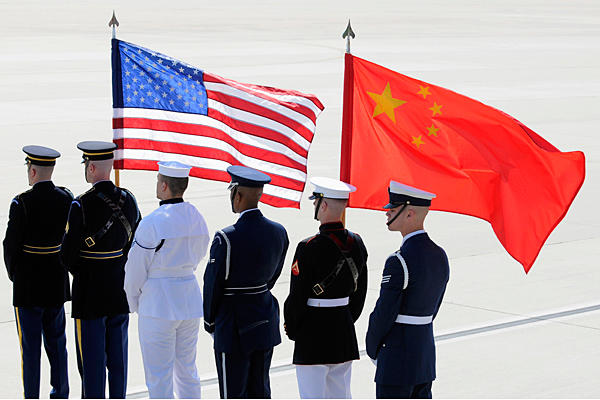
Generally speaking, since President Xi Jinping met with President Obama at the Annenberg Estate in June 2013, China-U.S. military relations have maintained continuity and stability, but frictions also interweave this relationship. These relations in 2017 can be characterized by the following three features.
I. Harmful Moves
Since President Donald Trump took office, the U.S. military has engaged in some harmful moves to contain China. As planned, over 60% of the U.S.’ military capabilities and most of its advanced platforms will be deployed to the Asia-Pacific region. On February 2, 2017, the most advanced early-warning E-2D airplanes arrived at Iwakuni, Japan. In September, the deployment of the THAAD system in South Korea was completed. In October, the Joint Communiqué of the 49th ROK-U.S. Security Consultative Meeting reiterated U.S. “commitments to enhance rotational deployments of U.S. strategic assets in and around the Korean Peninsula”. In November, for the first time, three carrier strike groups gathered in the Western Pacific for a joint exercise.
The U.S. military has also stepped-up “freedom of navigation” operations. On February 18, the USS Carl Vinson carrier strike group entered the South China Sea, the first patrol by a U.S. carrier in the region since President Trump took office. On May 25, July 2, and October 10 respectively, the missile destroyer USS Dewey entered the waters of the islands and reefs of the Nansha Islands without permission, and the missile destroyer USS Stethem and the missile destroyer Chafee trespassed into China’s territorial waters off the Xisha Islands. The last two operations were especially provocative, since there is no dispute around the Xisha Islands.
The U.S. military also increased contacts with Taiwan. The National Defense Authorization Act for Fiscal Year 2017 urged the Secretary of Defense to “carry out a program of exchanges of senior military officers and senior officials between the United States and Taiwan designed to improve military to military relations”. This is the first time that an elevation of U.S.-Taiwan military exchanges was required by law. At the 16th Shangri-La Dialogue on June 3, James Mattis promised that U.S. DoD would provide Taiwan with defense articles, fulfilling its obligations under the Taiwan Relations Act. It is the first time a U.S. Secretary of Defense mentioned Taiwan at the Shangri-La Dialogue, setting a bad precedent. Signed into law by President Trump on December 12, the National Defense Authorization Act for Fiscal Year 2018 suggests “considering the advisability and feasibility of reestablishing port of call exchanges between the United States navy and the Taiwan navy”; and “normalizing the arms sales process with Taiwan”. On June 29, the Trump administration notified Congress of $1.42 billion worth of arms sale to Taiwan. All these moves have encouraged Taiwan independence forces.
II. Two Stabilizers
Fortunately, despite those frictions, high-level communication and crisis management have served as stabilizers. On April 7 at Mar-a-Lago, President Xi Jinping pointed out that the bilateral military relationship was an important component of bilateral relations, and mutual trust in military and security fields was essential. During President Trump’s first visit to China last month, both heads of state reiterated the importance of military relations. They are committed to expanding exchanges and dialogues between the two militaries at various levels. In addition, the first round of diplomatic and security dialogues was successfully held in June. The two sides agreed to have annual exchanges and cooperation programs and to enhance high-level contacts to arrange visits for the defense ministers of the two countries and a visit to China by the Chairman of the Joint Chiefs of Staff of the U.S. At a press briefing, Secretary of Defense Mattis commented that “we gained a glimpse of a mutually beneficial future that we can create”. In the dialogue the two sides tackled major issues, like the North Korean nuclear issue, the South China Sea, counter-terrorism, and the Middle East. Such timely high-level communications and dialogues help to remove risks and release pressure.
Crisis management has also been effective. Both the cool-headed settlement of the unmanned undersea vehicle incident in December 2016, and the Chinese navy’s coordination with the U.S. in South China Sea to search for the missing sailor in August 2017, demonstrated that both sides desire “no conflict” and “no confrontation,” and that the two memorandums of understanding on confidence building measures signed in 2014 are working. Additionally, the first Joint Staff Dialogue also focused on crisis management and risk control. Thanks to frequent high-level communication and effective crisis management, in the face of frictions and differences, both countries will not take those measures that would jeopardize their military-to-military relationship.
III. Steady Exchanges
The continuous military contacts in 2017 have cultivated a habit of cooperation, and enhanced mutual trust and understanding.
Held in January, the 12th China-US Defense Policy Consultation Talk reached agreement on over 50 exchange items. Although it was reached by the Obama administration, all the 50 items are being conducted one by one as scheduled. For example, Admiral Scott Swift, Commander of the Pacific Fleet, visited China in June and invited the Chinese navy to participate in the RIMPAC-2018 exercise; Marine Corps General Joseph Dunford, Chairman of the U.S. Joint Chiefs of Staff, visited China in August and was received by President Xi Jinping; and in November, a week-long joint humanitarian and disaster relief exercise and seminar was held in Oregon. Since its inception in 1997, there have been 13 academic seminars, 5 command post drills and 4 live-troop training sessions.
From the development of China-U.S. military relations in 2017, we can see that, though the degree of military exchanges is not deeper than those in the economic field, the military relationship has become the highlight of bilateral relations. It is no longer the “shortest board” or the “weakest link”, but is playing a unique role of “underpinning support.”
In the midst of so many uncertainties under the Trump administration, there is still a benign interaction between the two militaries. The Chinese side deserves credit. China’s tradition of “cherishing the whole world” and its great efforts to build a community of shared future, as will help overcome the “Thucydides Trap”. PLA personnel have strictly followed the code for unplanned encounters at sea and the “code of safe conduct for sea and air encounters”, and showed great tolerance, restraint, and professionalism.
Looking ahead, to elevate the military relationship, the U.S. side might provide three assurances.
First, policy assurances. Up till now, the Trump administration’s policy toward China is still fragmental, based on deals. There is no strategic orientation, no certainty or consistency. There are also still vacancies in security and military offices. These things don’t help the stability of the China-U.S. military relationship. The new batch of strategic review reports should show less hostility towards China and provide more positive description of China.
Second, legal assurances. We call for repealing the sections of the National Defense Authorization Act for Fiscal Year 2000, which restrict China-U.S. military contacts in 12 areas and require the submission of an annual report on military and security developments involving China. At the same time, the U.S. might make laws to facilitate China-U.S. military exchanges on things like humanitarian assistance and disaster relief and counter-terrorism so these drips and drops might one day form a stream of cooperation.
Third, communications assurances. We hope both sides can maintain unimpeded channels of communication. We should make good use of track 1 platforms, like the diplomatic and security dialogue, and add some security working groups. The U.S. side should actively respond to and participate in track 1.5 multilateral platforms initiated by China, like the Xiangshan Forum. Last but not least, both sides should expand track 2 dialogue mechanisms and widely discuss military-to-military regional and global issues.


